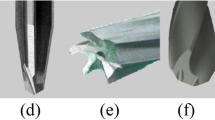Abstract
Carbon fiber-reinforced polymer (CFRP) composites are considered as difficult-to-machine materials. Due to good strength to weight ratio and comparatively light weight than metallic alloys, their usage in aerospace industry is increasing where drilling is primary machining process for joining of components. Material removal using drilling process in CFRP composites is challenging due to its abrasive nature together with certain problems such as matrix burn out and uncut fibers etc. The advantages associated with orbital drilling over conventional drilling technique are now established. Literature review in orbital drilling of CFRP composites revealed that published data is limited to geometrical and analytical modeling while loading a cutting tool in rotation as well as in orbital motion. In the current work, orbital drilling (OD) is performed by rotating the workpiece in an orbit instead of cutting tool. Cutting tool is used for spindle speed only. Thickness of the workpiece and tool surface condition was studied at two levels, i.e., 6 mm and 8 mm when employing coated and uncoated cutting tools. Holes of three different diameters of 8, 10, and 12 mm were drilled. Tool wear, workpiece surface roughness, and diametric error were reduced due to less loading on the cutting tool. Performance of coated tool was found to be better than its uncoated counterparts on all output responses.















Similar content being viewed by others
References
Denkena B, Boehnke D, Dege JH (2008) Helical milling of CFRP-titanium layer compounds. CIRP J Manuf Sci Technol 1(2):64–69
Brinksmeier E, Fangmann S, Meyer I (2008) Orbital drilling kinematics. Prod Eng 2(3):277–283
Whinnem E, Lipczynski G, Eriksson I (2010) Development of orbital drilling for the Boeing 787. SAE Int J Aerosp 1(1):811–816
Ishibashi T, Tanaka H, Yanagi K (2009) An analytical model for orbital drilling and its applicability. Proc. 24th Annu. Meet. Am. Soc. Precis. Eng. ASPE 2009, pp 1–4
Nespor D (2016) Process force prediction in orbital drilling of process force prediction in orbital drilling of TiAl6V4
Li Z, Liu Q, Peng C, Sun X (2011) Cutting force modeling and simulation for hole-making process by helical milling. Fourth Int. Semin. Mod. Cut. Meas. Eng, vol 7997, p 799703
Sadek A, Meshreki M, Attia MH (2012) Characterization and optimization of orbital drilling of woven carbon fiber reinforced epoxy laminates. CIRP Ann Manuf Technol 61(1):123–126
Wang H, Qin X, Ren C, Wang Q (2012) Prediction of cutting forces in helical milling process. Int J Adv Manuf Technol 58(9–12):849–859
Qin X, Wang B, Wang G, Li H, Jiang Y, Zhang X (2014) Delamination analysis of the helical milling of carbon fiber-reinforced plastics by using the artificial neural network model. J Mech Sci Technol 28(2):713–719
Tanaka H, Yoshita T (2015) Machinability evaluation of inclined planetary motion milling system for difficult-to-cut materials. Key Eng Mater 656–657:320–327
Tanaka H, Ohta K, Takizawa R, Yanagi K (2012) Experimental study on tilted planetary motion drilling for CFRP. Procedia CIRP 1(1):443–448
Tanaka H, Ota K, Takizawa R, Yanagi K, Co NSS (2013) Invited paper experimental study on inclined planetary mechanism drilling for carbon fiber reinforced plastic. In: International symposium on ultraprecision engineering and nanotechnology, Tokyo, Japan, pp 23–28
Ohta K, Tanaka H, Takizawa R (2012) Development of tilted planetary drilling system. Procedia CIRP 1(1):681–682
Sakamoto S, Iwasa H (2012) Effect of cutting revolution speed on cutting temperature in helical milling of CFRP composite laminates. Key Eng Mater 523–524:58–63
Eguti CCA, Trabasso LG (2014) Design of a robotic orbital driller for assembling aircraft structures. Mechatronics 24(5):533–545
Fang Q, Ke Y-L, Han B, Xu G-H, Pan Z-M, Fei S-H (2015) A force sensorless method for CFRP/Ti stack interface detection during robotic orbital drilling operations. Math Probl Eng 2015:1–11
Chen QL, Chen XM, Duan ZH, Cun WY (2014) Research on helical milling specialized tool based on chip-splitting mechanism. Adv Mater Res 1061–1062:497–506
Chen XM, Chen QL, He FT, Fan XF (2014) Experimental study on orbital drilling force and machining quality of CFRP. Adv Mater Res 1061–1062:542–549
Voss R, Henerichs M, Kuster F (2016) Comparison of conventional drilling and orbital drilling in machining carbon fibre reinforced plastics (CFRP). CIRP Ann Manuf Technol 65(1):137–140
Haiyan W, Xuda Q, Hao L, Chengzu R (2013) Analysis of cutting forces in helical milling of carbon fiber-reinforced plastics. Proc Inst Mech Eng B J Eng Manuf 227(1):62–74
Acknowledgments
The work is a part of thesis submitted for Partial fulfillment MSc Manufacturing Engineering degree completed from Industrial and Manufacturing Engineering Department, UET Lahore, Pakistan.
Author information
Authors and Affiliations
Corresponding author
Additional information
Publisher’s note
Springer Nature remains neutral with regard to jurisdictional claims in published maps and institutional affiliations.
Rights and permissions
About this article
Cite this article
Ahmad, N., Khan, S.A. & Raza, S.F. Influence of hole diameter, workpiece thickness, and tool surface condition on machinability of CFRP composites in orbital drilling: a case of workpiece rotation. Int J Adv Manuf Technol 103, 2007–2015 (2019). https://doi.org/10.1007/s00170-019-03713-2
Received:
Accepted:
Published:
Issue Date:
DOI: https://doi.org/10.1007/s00170-019-03713-2




